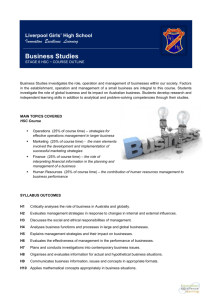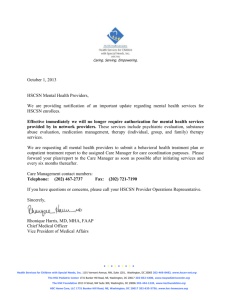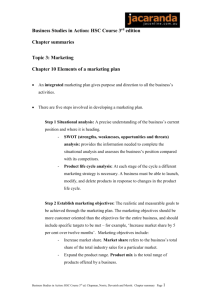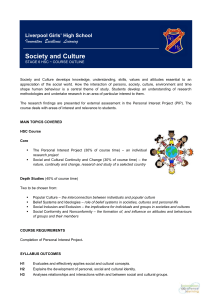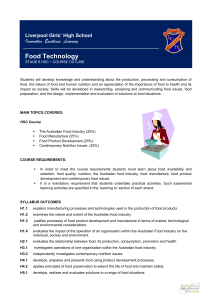BS HSC Handbook 2015 - Northlakes High School
advertisement
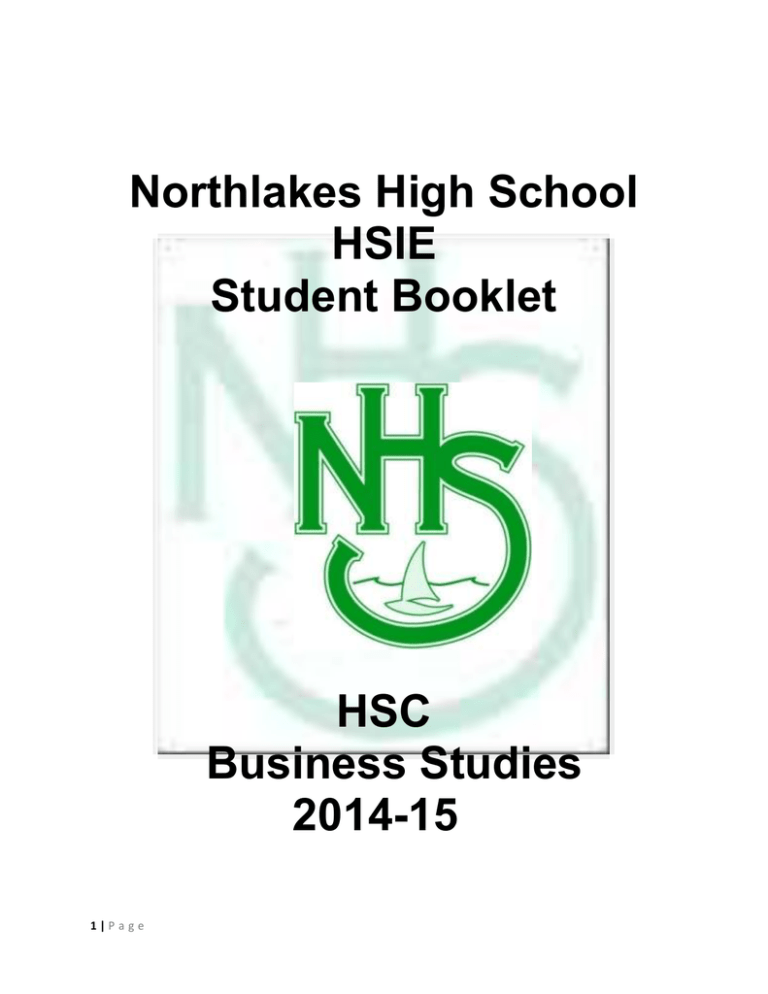
Northlakes High School HSIE Student Booklet HSC Business Studies 2014-15 1|P a g e Contents Northlakes HSC Scope and Sequence............................................3 Assessment Task Schedule.............................................................4 Course Objectives and Outcomes...................................................5 Course Overview and Content ........................................................6 Summary of external and internal HSC assessment.....................14 HSC examination specifications.....................................................14 Performance Band Descriptors.......................................................15 Subject Glossary............................................................................N/A Directive Verb Glossary...................................................................16 Websites..........................................................................................17 2|P a g e NORTHLAKES HIGH SCHOOL YEAR 12 HSC – Business studies YEARLY PLANNER 2014/15 Term 4: Tuesday 7/10/12 – Friday 18/12/12 Week 1 Week 2 Week 3 Week 4 7/10 13/10 20/10 Week 5 Week 6 Week 7 Week 8 Week 9 Week 10 Week 11 311 10/11 17/11 24/11 1/12 8/12 15/12 27/10 Assess Task #1 Marketing Week1 27/1 Week 2 2/2 Week 3 9/2 Week 4 16/2 Week 5 23/2 Week 6 2/3 Week 7 9/3 Week 8 16/3 Finance Finance Feedback kgWeek 10 Week 9 23/3 30/3 Assess Task Operations #2 Feedback Week 1 20/4 Week 2 Week 3 27/4 Week 4 Week 5 Week 6 Week 7 Week 8 Week 9 11/5 18/5 25/5 1/6 8/6 15/6 4/5 Human Resources Operations Week 1 Week 2 Week 3 Week 4 13/7 HR 3|P a g e 20/7 27/7 3/8 TRIAL HSC AssessTask 4 Assess Task #3 Week 10 22/6 Human Resources Week 5 Week 6 Week 7 Week 8 Week 9 Week 10 10/8 17/8 24/8 31/8 7/9 14/9 FEEDBACK REVISION REVISION REVISION REVISION REVISION REVISION Assessment schedule BUSINESS STUDIES - 2 UNIT Higher School Certificate 2015 Task 1 Week: 10 Term: 4, 2014 Marketing Test: Structured Short Answer Task 2 Week: 9 Term: 1, 2015 Financial Stimulus Activity Task 3 Week: 8 Term: 2, 2015 Report/ Casestudy Task 4 Week: 3/4 Term: 3, 2015 Trial HSC Components Weighting Knowledge & Understanding 40% Stimulus-based skills 20% Inquiry and Research 20% 20% Communication 20% 10% 10% TOTAL MARKS: 100% Outcomes 20% 20% 20% 20% 20% 30% 30% H3, H5, H6 H4, H7, H9, H10 H2, H8 H1, H3, H6, H10 Outcomes H1 Critically analyses the role of business in Australia and globally H2 Evaluates management strategies in response to changes in internal and external influences H3 Discusses the social and ethical responsibilities of management H4 Analyses business functions and processes in large and global businesses H5 Explains management strategies and their impact on businesses H6 Evaluates the effectiveness of management in the performance of business H7 Plans and conducts investigations into contemporary business issues H8 Organises and evaluates information for actual and hypothetical business situations H9 Communicates business information, issues and concepts in appropriate formats H10 Applies mathematical concepts appropriately in business situations 4|P a g e Objectives and Outcomes Objectives: The student develops knowledge and understanding about: HSC outcomes The nature, role and structure of H1 business Internal and external influences H2 on business Critically analyses the role of business in Australia and globally Evaluates management strategies in response to changes in internal and external influences The student: H3 Discusses the social and ethical responsibilities of management Analyses business functions and processes in large and global businesses The functions and processes of business activity H4 Management strategies and their effectiveness H5 Explains management strategies and their impact on businesses H6 Evaluates the effectiveness of management in the performance of business The student develops skills to: investigate, synthesise and H7 evaluate contemporary business H8 issues and hypothetical and actual business situations communicate business information and issues using appropriate formats apply mathematical concepts appropriate to business situations 5|P a g e Plans and conducts investigations into contemporary business issues Organises and evaluates information for actual and hypothetical business situations H9 Communicates business information, issues and concepts in appropriate formats H10 Applies mathematical concepts appropriately in business situations HSC Course Overview HSC course structure (120 indicative hours) Topic Indicative hours % of course time Operations 30 25 Marketing 30 25 Finance 30 25 Human resources 30 25 Content: HSC Course 10.1 HSC topic: Operations 25% of indicative time The focus of this topic is the strategies for effective operations management in large businesses. Outcomes The student: H1 critically analyses the role of business in Australia and globally H2 evaluates management strategies in response to changes in internal and external influences H3 discusses the social and ethical responsibilities of management H4 analyses business functions and processes in large and global businesses H5 explains management strategies and their impact on businesses H6 evaluates the effectiveness of management in the performance of businesses H7 plans and conducts investigations into contemporary business issues H8 organises and evaluates information for actual and hypothetical business situations H9 communicates business information, issues and concepts in appropriate formats Content Students learn to: examine contemporary business issues to: discuss the balance between cost and quality in operations strategy examine the impact of globalisation on operations strategy identify the breadth of government policies that affect operations management explain why corporate social responsibility is a key concern in operations management investigate aspects of business using hypothetical situations and actual business case studies to: describe the features of operations management for businesses in a tertiary industry 6|P a g e assess the relationship between operations and the other key business functions in two actual businesses explain how operations strategy can help a business sustain its competitive advantage recommend possible operations strategies for one hypothetical business Students learn about: role of operations management strategic role of operations management – cost leadership, good/service differentiation goods and/or services in different industries interdependence with other key business functions influences globalisation, technology, quality expectations, cost-based competition, government policies, legal regulation, environmental sustainability corporate social responsibility – the difference between legal compliance and ethical responsibility – environmental sustainability and social responsibility operations processes inputs – transformed resources (materials, information, customers) – transforming resources (human resources, facilities) transformation processes – the influence of volume, variety, variation in demand and visibility (customer contact) – sequencing and scheduling – Gantt charts, critical path analysis – technology, task design and process layout – monitoring, control and improvement outputs – customer service – warranties operations strategies performance objectives – quality, speed, dependability, flexibility, customisation, cost new product or service design and development supply chain management – logistics, e-commerce, global sourcing outsourcing – advantages and disadvantages technology – leading edge, established inventory management – advantages and disadvantages of holding stock, LIFO (last-in-first-out), FIFO (first-in-first-out), JIT (just-in-time) quality management – control – assurance – improvement overcoming resistance to change – financial costs, purchasing new equipment, redundancy payments, retraining, reorganising plant layout, inertia global factors – global sourcing, economies of scale, scanning and learning, research and development 7|P a g e 10.2 HSC topic: Marketing 25% of indicative time The focus of this topic is the main elements involved in the development and implementation of successful marketing strategies. Outcomes The student: H1 critically analyses the role of business in Australia and globally H2 evaluates management strategies in response to changes in internal and external influences H3 discusses the social and ethical responsibilities of management H4 analyses business functions and processes in large and global businesses H5 explains management strategies and their impact on businesses H6 evaluates the effectiveness of management in the performance of businesses H7 plans and conducts investigations into contemporary business issues H8 organises and evaluates information for actual and hypothetical business situations H9 communicates business information, issues and concepts in appropriate formats H10 applies mathematical concepts appropriately in business situations Content Students learn to: examine contemporary business issues to: explain why goods and/or services are central to both marketing and operations examine why ethical behaviour and government regulation are important in marketing assess why a mix of promotional strategies is important in the marketing of goods and services investigate aspects of business using hypothetical situations and actual business case studies to: evaluate the marketing strategies for a good or service analyse a marketing plan for a business explain how globalisation has affected marketing management Students learn about: role of marketing strategic role of marketing goods and services interdependence with other key business functions production, selling, marketing approaches types of markets – resource, industrial, intermediate, consumer, mass, niche influences on marketing factors influencing customer choice – psychological, sociocultural, economic, government consumer laws 8|P a g e – deceptive and misleading advertising – price discrimination – implied conditions – warranties ethical – truth, accuracy and good taste in advertising, products that may damage health, engaging in fair competition, sugging marketing process situational analysis – SWOT, product life cycle market research establishing market objectives identifying target markets developing marketing strategies implementation, monitoring and controlling – developing a financial forecast; comparing actual and planned results, revising the marketing strategy marketing strategies market segmentation, product/service differentiation and positioning products – goods and/or services – branding – packaging price including pricing methods – cost, market, competition-based – pricing strategies – skimming, penetration, loss leaders, price points – price and quality interaction promotion – elements of the promotion mix – advertising, personal selling and relationship marketing, sales promotions, publicity and public relations – the communication process – opinion leaders, word of mouth place/distribution – distribution channels – channel choice – intensive, selective, exclusive – physical distribution issues – transport, warehousing, inventory people, processes and physical evidence e-marketing global marketing – global branding – standardisation – customisation – global pricing – competitive positioning 9|P a g e 10.3 HSC topic: Finance 25% of indicative time The focus of this topic is the role of interpreting financial information in the planning and management of a business. Outcomes The student: H2 evaluates management strategies in response to changes in internal and external influences H3 discusses the social and ethical responsibilities of management H4 analyses business functions and processes in large and global businesses H5 explains management strategies and their impact on businesses H6 evaluates the effectiveness of management in the performance of businesses H7 plans and conducts investigations into contemporary business issues H8 organises and evaluates information for actual and hypothetical business situations H9 communicates business information, issues and concepts in appropriate formats H10 applies mathematical concepts appropriately in business situations Content Students learn to: examine contemporary business issues to: explain potential conflicts between short-term and long-term financial objectives analyse the influence of government and the global market on financial management identify the limitations of financial reporting compare the risks involved in domestic and global financial transactions investigate aspects of business using hypothetical situations and actual business case studies to: calculate key financial ratios assess business performance using comparative ratio analysis recommend strategies to improve financial performance examine ethical financial reporting practices Students learn about: role of financial management strategic role of financial management objectives of financial management – profitability, growth, efficiency, liquidity, solvency – short-term and long-term interdependence with other key business functions influences on financial management internal sources of finance – retained profits 10 | P a g e external sources of finance – debt – short-term borrowing (overdraft, commercial bills, factoring), long-term borrowing (mortgage, debentures, unsecured notes, leasing) – equity – ordinary shares (new issues, rights issues, placements, share purchase plans), private equity financial institutions – banks, investment banks, finance companies, superannuation funds, life insurance companies, unit trusts and the Australian Securities Exchange influence of government – Australian Securities and Investments Commission, company taxation global market influences – economic outlook, availability of funds, interest rates processes of financial management planning and implementing – financial needs, budgets, record systems, financial risks, financial controls – debt and equity financing – advantages and disadvantages of each – matching the terms and source of finance to business purpose monitoring and controlling – cash flow statement, income statement, balance sheet financial ratios – liquidity – current ratio (current assets ÷ current liabilities) – gearing – debt to equity ratio (total liabilities ÷ total equity) – profitability – gross profit ratio (gross profit ÷ sales); net profit ratio (net profit ÷ sales); return on equity ratio (net profit ÷ total equity) – efficiency – expense ratio (total expenses ÷ sales), accounts receivable turnover ratio (sales ÷ accounts receivable) – comparative ratio analysis – over different time periods, against standards, with similar businesses limitations of financial reports – normalised earnings, capitalising expenses, valuing assets, timing issues, debt repayments, notes to the financial statements ethical issues related to financial reports financial management strategies cash flow management – cash flow statements – distribution of payments, discounts for early payment, factoring working capital management – control of current assets – cash, receivables, inventories – control of current liabilities – payables, loans, overdrafts – strategies – leasing, sale and lease back profitability management – cost controls – fixed and variable, cost centres, expense minimisation – revenue controls – marketing objectives global financial management – exchange rates – interest rates – methods of international payment – payment in advance, letter of credit, clean payment, bill of exchange – hedging – derivatives 11 | P a g e 10.4 HSC topic: Human resources 25% of indicative time The focus of this topic is the contribution of human resource management to business performance. Outcomes The student: H2 evaluates management strategies in response to changes in internal and external influences H3 discusses the social and ethical responsibilities of management H4 analyses business functions and processes in large and global businesses H5 explains management strategies and their impact on businesses H6 evaluates the effectiveness of management in the performance of businesses H7 plans and conducts investigations into contemporary business issues H8 organises and evaluates information for actual and hypothetical business situations H9 communicates business information, issues and concepts in appropriate formats Content Students learn to: examine contemporary business issues to: discuss the influence of government on the process of determining employment contracts explain how businesses exhibit corporate social responsibility in the management of human resources analyse the causes of two workplace disputes and the strategies used to resolve them examine the advantages of a diverse, culturally competent workforce for a global business investigate aspects of business using hypothetical situations and actual business case studies to: explain the interdependence between human resources and other key business functions compare the process of negotiating enterprise/collective agreements with the negotiation of individual contracts discuss the advantages and disadvantages of outsourcing in the global market evaluate the effectiveness of human resource management for one business and recommend appropriate alternative strategies Students learn about: role of human resource management strategic role of human resources interdependence with other key business functions outsourcing – human resource functions – using contractors – domestic, global 12 | P a g e key influences stakeholders – employers, employees, employer associations, unions, government organisations, society legal – the current legal framework – the employment contract – common law (rights and obligations of employers and employees), minimum employment standards, minimum wage rates, awards, enterprise agreements, other employment contracts – occupational health and safety and workers compensation – antidiscrimination and equal employment opportunity economic technological social – changing work patterns, living standards ethics and corporate social responsibility processes of human resource management acquisition development maintenance separation strategies in human resource management leadership style job design – general or specific tasks recruitment – internal or external, general or specific skills training and development – current or future skills performance management – developmental or administrative rewards – monetary and non-monetary, individual or group, performance pay global – costs, skills, supply workplace disputes – resolution – negotiation, mediation, grievance procedures, involvement of courts and tribunals effectiveness of human resource management indicators – corporate culture – benchmarking key variables – changes in staff turnover – absenteeism – accidents – levels of disputation – worker satisfaction 13 | P a g e Summary of external and internal HSC assessment External examination Section I Objective response questions Section II Short-answer questions Section III Candidates answer one extended response question in the form of a business report Section IV Candidates answer one extended response question 100 Internal assessment Knowledge and understanding of course content Stimulus-based skills Inquiry and research Communication of business information, ideas and issues in appropriate forms 100 Mark 20 40 20 20 Weighting 40 20 20 20 No more than 50% weighting may be allocated to tests and examinations. HSC examination specifications Business Studies HSC examination specifications to apply from the HSC 2012. The examination will consist of a written paper worth 100 marks. Time allowed: 3 hours plus 5 minutes reading time. The paper will consist of four sections. Section I (20 marks) There will be objective-response questions worth 20 marks. Section II (40 marks) There will be four to six short-answer questions. Questions may be in parts. There will be approximately 12 items in total. Section III (20 marks) There will be one question that requires an extended response in a business report format. This question will incorporate elements from across topics in the HSC course. The expected length of response will be around six pages of an examination writing booklet (approximately 800 words). Section IV (20 marks) There will be two extended-response questions. Candidates will be required to answer one question. Each question will be drawn from a different topic in the HSC course. The expected length of response will be around six pages of an examination writing booklet (approximately 800 words). 14 | P a g e Performance band descriptors Business Studies – Performance band descriptions The typical performance in this band: Band 6 demonstrates comprehensive knowledge and understanding of business functions and operations critically analyses the nature, role and structure of business evaluates the effectiveness of management responses to internal and external influences that affect business interprets and applies specific numerical data to analyse and solve business problems and predict future trends synthesises contemporary business issues when evaluating management responses and strategies clearly communicates using business terminology, concepts and comprehensive case studies in a variety of appropriate formats Band 5 demonstrates thorough knowledge and understanding of business functions and operations analyses the nature, role and structure of business analyses management responses to internal and external influences that affect business interprets and applies numerical data to analyse and solve business problems and predict future trends applies contemporary business issues when analyzing management responses and strategies communicates using business terminology, concepts and comprehensive case studies in a variety of appropriate formats Band 4 demonstrates knowledge and some understanding of business functions and operations explains the nature, role and structure of business explains management responses to internal and external influences that affect business interprets and applies numerical data with some analysis to solve business problems summarises contemporary business issues with some analysis of management responses and strategies communicates using business terminology, concepts and comprehensive case studies in descriptive formats Band 3 demonstrates basic understanding of business functions and operations describes the nature, role and structure of business describes management responses refers to numerical data when solving business problems displays limited analysis of contemporary business issues communicates using basic business terminology in simple formats Band 2 demonstrates limited understanding of business functions and operations demonstrates limited knowledge of the nature, role and structure of business identifies management responses uses elementary numerical data shows limited communication skills 15 | P a g e Directive Verb Glossary ACCOUNT State reasons for, report on, explain. Give an account of, narrate a series of events or transactions ANALYSE Identify components and the relationship between them, draw out and relate implications APPLY Use, utilise, employ in a particular situation APPRECIATE Make a judgment about the value of. Include evidence/examples ASSESS Make a judgment of value, quality, outcomes, results or size. Give your opinion with facts. CALCULATE Ascertain / determine from given facts, figures or information CLARIFY Make clear or plain CLASSIFY Arrange or include in classes / categories COMPARE Show how things are similar or different (hint – use a Venn diagram) CONSTRUCT Make, build, put together items or arguments CONTRAST Show how things are different or opposite CRITICALLY (analyse / evaluate) Add a degree or level of accuracy, depth, knowledge and understanding, logic, questioning, reflection and quality to analysis/evaluation DEDUCE Draw conclusions DEFINE State meaning and identify essential qualities DEMONSTRATE Show by example DESCRIBE Provide characteristics and features of the item / concept DISCUSS Identify issues and provide points for and/or against DISTINGUISH Recognise and indicate as being distinct or different from, to note differences between things EVALUATE Make a judgment and give your opinion based on criteria, determine the value of EXAMINE Inquire into, find out the facts EXPLAIN Relate cause and effect, make the relationships between things evident, provide the why and/or how about the item / concept EXTRACT Choose relevant and/or appropriate details EXTRAPOLATE Infer from what is known IDENTIFY Recognise and name INTERPRET Draw meaning from INVESTIGATE Plan, inquire into and draw conclusions about JUSTIFY Support an argument or conclusion with evidence and examples OUTLINE Sketch in general terms, indicate the main features of PREDICT Suggest what may happen based on available information PROPOSE Put forward a point of view, idea, argument or suggestion for consideration or action RECALL Present remembered ideas, facts or experiences RECOMMEND Provide reasons in favour RECOUNT Retell a series of events SUMMARISE Concisely express the relevant details SYNTHESISE Putting together various elements to make a whole 16 | P a g e Websites Some useful websites for Study Guides and Strategies: www.hsc.csu.edu.au (Each of the universities websites also has tips and guides, so try a search under their names.) 17 | P a g e
